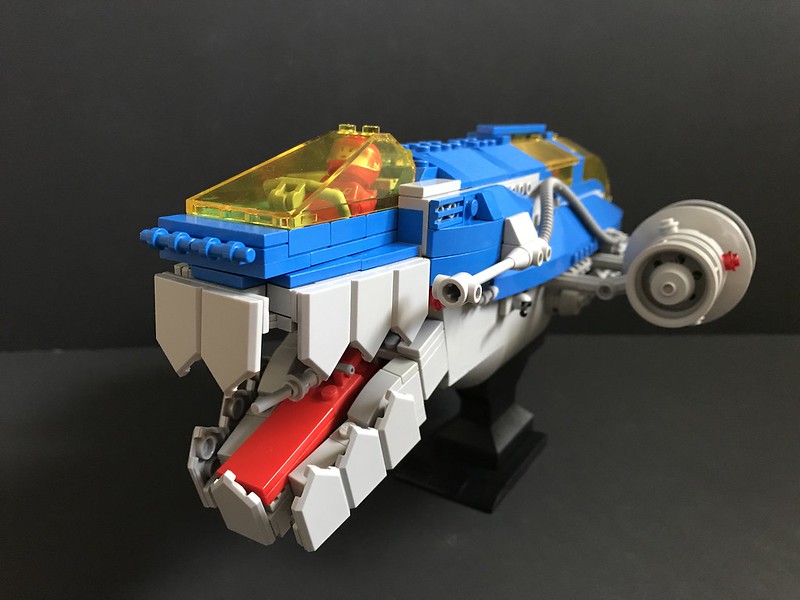
The System. Brightly coloured business tyranny of a half-dozen ruthless transcorporations who dominate and control human exploitation of the solar system.
Bound over to a Dark Side hypercapitalist creed of profit maximisation at the expense of individual lives and freedoms, the System owns everything, dividing up the worlds between the several megacorporate business interests and enforcing their will through both the theoretically independent Space Police organisation and internal transcorporate security forces.

Despite occasional turf wars and bloody takeover battles over the control of their various subsidiaries, the half-dozen major transcorporations collude as much as they compete, with the directorates of Bencom, TransOctan, Lagrange-Lunacorp and the others in full agreement over the basic tenets of their pseudocapitalistic corporate feudalism and its overall expression in the System.

A growing protest movement has emerged, using stark black as a unifying colour in reaction to the brightly-coloured transcorporate liveries used by the major economic players, and bearing a triple-triangle emblem representing the ancient French Revolutionary battle cry of “Liberté, Egalité, Fraternité”. Dubbed “Blacktron” by the Bencom-controlled media outlets (who tried to pin the blame for the disturbances on the TransOctan Group’s takeover of Bencom’s financial subsidiary Atlas Solutions), the protesters are drawn from a cross-section of idealists and radicals across all the major transcorporations up and down the economic ladder.

Ruthlessly suppressed by transcorporate goon squads with the full support of the Space Police organisation whose mission is in theory to uphold the last vestiges of real law in the System, the movement spreads underground by word of mouth, liberated communications and graffiti scrawled on outpost walls, a David-and-Goliath alliance of motley rebels who may be the last best hope of humanity…
~~~

Several of my recent builds have been tied into my dystopian Brightly Coloured Tyranny universe in their descriptions, but this is the first time I’ve specifically built anything that couldn’t be a more generic Neoclassic Space creation.

Since the System is a Brightly Coloured Tyranny, it’s a fairly certain bet that anywhere out of the direct eye of the directorate classes is going to be underfinanced and broken-down, and it’s actually been a lot of fun putting together a ramshackle, tumbledown version of the Classic Space theme. It’s also let me bring in colours that never usually belong in a Neoclassic Space build; most significantly dark grey, but I’m also making judicious use of flat silver and dark tan.
There are quite a few fun little details here. The guy riding the speeder bike looks absolutely terrified of the Space Police officer. The officer does look rather brutal – she’s actually Cyren from the Ninjago theme, and the only yellow head in the entire build.


There’s a security camera on the wall, casting a roving, Big Brother eye over that part of the build. Predictably, it seems in far better working order than the various lighting fixtures, half of which have missing or broken bulbs.
On the middle level are the armed transcorporate goon squads, behind their dehumanising black visors. If the traditional polarity of “Classic Space good, Blacktron bad” is reversed here, then it’s the Blacktron who need the humanising touch of being able to see their faces and the Classic astronauts who need the darkened visors. Or at least the transcorporate security forces.

Down below, it’s a lot more ratty and grim-looking, with dark grey (new greys throughout as usual) predominating and more dark tan. Here are the Blacktron protesters, one of whom is being gunned down by a blue-suited Bencom enforcer. The protesters have homemade signs, both because I’m a cheapskate and because I wanted the look of hand-drawn signs. With one protester down, I figured a little blood wouldn’t be out of place, even if it ups the classification rating somewhat. This is the first time I’ve built anything with bloodstains in it; normally I stay within the boundaries of a Universal/General rating.

The Futuron dude looks suitably horrified at the brutality of the transcorporate security forces; the Brightly Coloured Tyranny universe isn’t a simple case of Blacktron versus the world, but a more complex and nuanced world in which some of the brightly coloured astronauts might be sympathetic civilians, or System partisans, or apathetic, or anything in between.
I’m not sure “I hope you like it” is the right thing to say with a build like this, but you know what I mean. It’s a gritty and dystopian build, but I’m really satisfied with how it’s turned out.




































